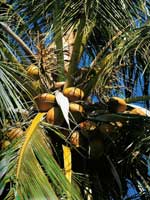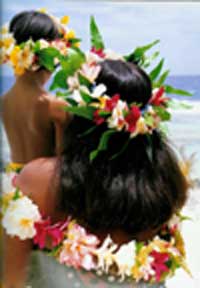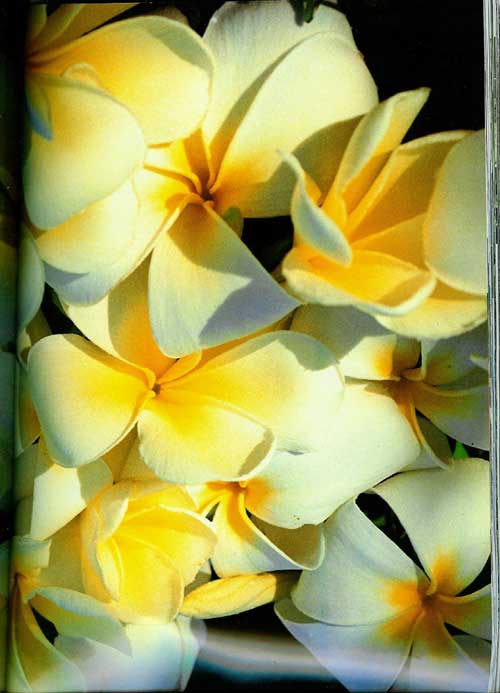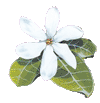|
STORY
OF MONOI
ancient elixir of the
Pacific that’s new in the West
Monoi
is a natural product of the coconut, the iconic tree of the tropical
Pacific Ocean. The
coconut palm grows in all the islands of the region and is central to
the diet as well as the spiritual and material life of the people.
Ancient origins
The
steeping or maceration of gardenia flowers in coconut oil is an ancient
tradition of the Pacific that pre-dates any European contact.
The earliest European knowledge of monoi had to wait until the 18th
century when Captain James Cook first observed and recorded it during
his visit to Tahiti in 1769.

In
his log he describes the islanders as “very cleanly people both in
their persons and diet, always washing before and after meals and
bathing in fresh water three times a day;
and they anoint themselves with monoi, as they call it,
this is made of coconut oil in which some sweet herbs or flowers are
infused”.
The best known source of monoi today is still that produced in Tahiti,
French Polynesia.
Cocos nucifera
Monoi
is 97% pure coconut oil, and as such represents a significant usage of
the fruit of the palm in the South Pacific.
The tree grows prolifically all over the islands and is the most
utilised Polynesian island tree, covering 150,000 acres of land.
The palm will develop its first fruits in its sixth year and will
produce up to sixty coconuts a year for seventy years.
However, in spite of the increasing use of coconuts for their
oil, it is estimated that 90% of coconuts in the Pacific go to waste, a
statistic that should encourage us to make greater use of this natural
resource.

When
they are fully mature, the nuts fall from the tree and are then gathered
and split. The halves are left to dry for several hours in the
sun, when the kernel is removed and air dried on special racks until it
has lost nearly all of its moisture.
The dried kernel known as copra is taken to the mill, crushed and
pressed, and later filtered.
Gardenia tahitensis
Once
the filtration process is completed the coconut oil is stabilised with
vitamin E and stored in special tanks until it is purchased by the small
number of monoi manufacturers who will proceed individually to the
maceration process in their respective factories.

The
essential ingredient at this stage is the Tahitian gardenia, which
provides perfume, oils and antiseptic properties to the finished
product. The gardenia
tahitensis is a small white flower of the family Rubiaceae
with six to eight petals, which is soaked or macerated in the oil at the
rate of not less than ten blooms per litre of oil for two weeks.
This specification is laid down in the French government’s
official stamp of Appellation d’Origine, a guarantee of authenticity
and quality which has raised monoi to the status of wine.
(Indeed it has been argued that, like wine, monoi will develop a
particularly fine mellowness when stored in glass bottles over many
years.)
The gardenia’s name in Tahitian is tiaré and its special
properties have been well researched by the Monoi Institute in Tahiti
and other independent laboratories.
Proven benefits of monoi oil
In
a world in which many wild claims are made for products and ingredients
and their supposed benefits, it is reassuring to see the careful
analysis that monoi has been subjected to by various laboratories.
In particular the Monoi Institute in Tahiti has published the
results of its analyses which are freely available on its web site www.monoi-institute.org,
while other French laboratories have published detailed analyses of the
oil and the Tahitian gardenia flower.
As
a natural product, monoi embodies many different substances working
synergetically together: a complex of benzoates, salicylates, oils and
waxes which are present in the final product because of the gentle
extraction process and long maceration.
The result is a product rich in active ingredients which will
nourish the skin over many hours.
Traditional
medicine
In
the traditional Tahitian pharmacopoeia, te ra’au Tahiti, monoi
was the most common remedy which the islanders used to soothe a variety
of ailments. Its
healing properties were well appreciated by the people, and it remains
today the basis of traditional herbal medicine.
Massage
oil
The
Polynesians used it also in the refined art of therapeutic massage, to
which they attributed great healing powers.
Monoi
is still used as massage oil, both for therapy and to relax the muscles
prior to the islanders’ demanding traditional canoe races and athletic
contests. It is
excellent for the purpose, leaving the skin feeling pleasingly soft and
supple without greasiness. In
fact the oil, while being quickly absorbed by the skin, will confer
proven hydrating and emollient qualities to it for several hours after
treatment. A big plus
for the client is the flowery aroma of the oil which emanates from the
skin for the rest of the day.
Hair care
Monoi
is used as a hair conditioner and has a reparative effect on dry and
damaged hair.

The
use of monoi for care of the hair in Polynesia has a long tradition and
was documented by Herman Melville in his well known work Typee,
an account of his time in the Marquesas islands published in 1846.
In it he writes:
The
Typee girls devote much of their time to the dressing of their beautiful
and abundant hair. After
bathing, as they sometimes do five or six times every day, the hair is
carefully dried, and if they have been in the sea, invariably washed in
fresh water, and anointed with a highly scented oil extracted from the
meat of the coconut. Its
merits as a preparation for the hair are undeniable – it imparts to it
a superb gloss and a silky fineness.
Women
in Tahiti use monoi as a beauty oil for both the skin and the hair, and
the claim is commonly made, with some justification, that “monoi is
their beauty secret”.
Other
flowers and essences
In
addition to the pure oil scented with gardenia, other flowers and
essences are commonly used to aromatise the monoi, which mostly have
traditional associations with particular groups of islands.
Frangipani (tipanié), jasmine (pitaté) and
ylang-ylang are the most popular flowers, while essence of sandalwood is
used as a fragrance for men. The vanilla bean, a crop for which Tahiti is famous, is also
used to give its soft and warm fragrance to the oil.

Monoi
producers
The
monoi producers of Tahiti have established a professional body to
provide information to the public and maintain standards.
This is the GIMT (Groupement Inter-professionel du Monoi de
Tahiti). Apart from providing full information, laboratory test
results and publications, the GIMT also organises a competition for new
formulas for cosmetics which incorporate monoi.
The
Parfumerie Tiki
A
small number of businesses in Tahiti produce monoi as a finished article
ready for use. One of
the best known is the Parfumerie Tiki, a long established family
business, whose policy is to keep to traditional ingredients and methods
of manufacture. Even the packaging has not changed from its
characteristic upright glass bottle and old fashioned label first
introduced in 1942. Each
bottle contains a gardenia flower, a delightful touch.
Parfumerie
Tiki was the first company in Tahiti to attempt the commercial
production of monoi. While
its oils provide an export product for the islands’ economy, the
greater part of the monoi produced by the factory is sold to the home
market, with 80% of Tiki monoi being used on a daily basis by the
inhabitants of Tahiti and her islands.
Of
all the elements of ancient Polynesian culture to have survived into the
modern world, monoi is surely one of the most beautiful.
|





